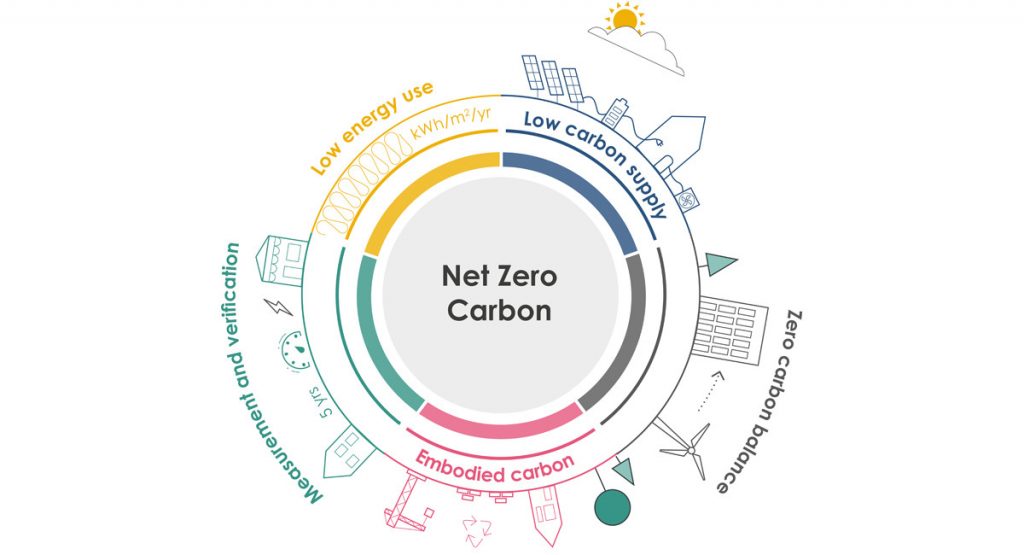It has been 18 months since two built environment guides were published sharing practical sustainable construction methods, to ensure new buildings meet the UK’s climate change targets.
The London Energy Transformation Initiative’s (LETI) Climate Emergency Design Guide informs on how to design and build zero carbon buildings.
The LETI was established to develop and deliver guidance on how built environment in London and across the UK can reach net zero targets – to reduce carbon emissions by 40% by 2030, and reach net zero by 2050.
In the UK, 49% of greenhouse gas emissions are attributable to buildings – 27% from commercial, 22% from domestic. And globally, 39% of carbon emissions come from buildings – 11% from embodied carbon, 28% from operational carbon:
- Embodied carbon – the emissions associated with the construction, including the manufacture, transportation, and erection of materials, and end-of-life, including demolition and recycling or reuse, of a building’s materials
- Operational carbon – the emissions associated with lighting, powering, heating or cooling buildings day-to-day
LETI and other industry leaders, including the World Green Building Council, say that all new buildings must operate at net zero by 2030 and all buildings must operate at net zero by 2050. Currently just 20% of new buildings operate at zero carbon.
Reducing operational carbon emissions
To meet net zero for operational carbon, new buildings must be powered, lit and temperature controlled using 100% renewable energy sources. Carbon offsets cannot be purchased to compensate for emissions.
To achieve this level of sustainable construction, the industry needs the right knowledge and skills. LETI’s guidance sets out guidelines and detail on implementable solutions for commercial, domestic and public building projects, including:
- Prioritising operational carbon more highly during the design stage of a build, to reduce day-to-day energy needs;
- Improving insulation, to reduce heat loss, and using renewable energy for heating and hot water;
- Accepting responsibility at every level – with a ‘golden thread’ of responsibility tying all individual contributions, from design through to construction;
- Maximising renewable energy generation through both on-site, such as roof-mounted solar panels, and off-site, such as wind energy, methods;
- Engaging facilities managers to understand how to operate energy efficient buildings and influence occupants to use energy responsibly;
Additionally, in order to measure progress and find new ways to improve, LETI’s guidance says that capturing and reporting data on building usage and energy consumption must be improved and standardized.
For now, LETI’s focus is on ensuring new buildings meet the strictest standards, so practices for retrofitting aren’t yet covered; though it stresses that its report will evolve and develop as more is learnt and understood within the industry.
Reducing embodied carbon emissions
Reducing embodied carbon will be essential to sustainable construction in the long run too. A report by WBCSD found that up to 50% of whole life carbon emissions in a building come from the manufacturing and construction processes of a build – following a whole life cycle assessment (WLCA) of six building projects.
The assessments were undertaken in a bid to use findings to define realistic pathways for the industry to achieve net zero targets at construction stage. It says that completing WLCAs on all projects is now essential, to build evidence and understanding of the construction and built environment sectors’ carbon emissions.
And since it’s estimated that 80% of the built environment we’ll be using in 2050 is already built, new solutions will need to extend to retrofitting existing building stock.
For contractors delivering at construction stage this requires circular economy principles, to:
- Build less – prioritising refurbishment of existing stock or reuse of materials
- Build light – considering the impact of a building’s structure
- Build wise – understanding a building’s longevity and local context.
- Build low carbon – reviewing building material’s specifications and whole-life carbon
- Build for the future – understanding a building’s adaptability or recyclability at end-of-life
- Build collaboratively – involving all contractors; as with the ‘golden thread’
For designers and steelwork contractors using structural steel, these principles in practice include (but are not limited to): using long span beams to grant adaptability for a building’s use, and using bolted connections or clamped fittings, over welded joints, to allow for re-use at end-of-life.
As LETI – a member organisation comprising 1,000+ built environment professionals – clearly demonstrates, collaboration is key to delivering sustainable construction projects. Main clients, contractors and supply chains must work together for designers and developers to deliver high performing buildings, fit for the future.
To read LETI’s guide in full, visit: Publications | LETI

